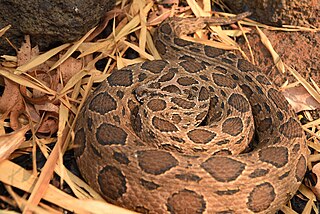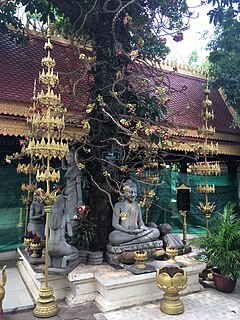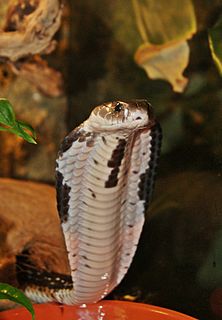
A banana is an elongated, edible fruit – botanically a berry – produced by several kinds of large herbaceous flowering plants in the genus Musa. In some countries, bananas used for cooking may be called "plantains", distinguishing them from dessert bananas. The fruit is variable in size, color, and firmness, but is usually elongated and curved, with soft flesh rich in starch covered with a rind, which may be green, yellow, red, purple, or brown when ripe. The fruits grow upward in clusters near the top of the plant. Almost all modern edible seedless (parthenocarp) bananas come from two wild species – Musa acuminata and Musa balbisiana. The scientific names of most cultivated bananas are Musa acuminata, Musa balbisiana, and Musa × paradisiaca for the hybrid Musa acuminata × M. balbisiana, depending on their genomic constitution. The old scientific name for this hybrid, Musa sapientum, is no longer used.

Ensete is a genus of monocarpic flowering plants native to tropical regions of Africa and Asia. It is one of the three genera in the banana family, Musaceae, and includes the false banana or enset, an economically important food crop in Ethiopia.

Eld's deer, also known as the thamin or brow-antlered deer, is an endangered species of deer endemic to South Asia.

The surilis are a group of Old World monkeys in the genus Presbytis. They live in the Thai-Malay Peninsula, on Sumatra, Borneo, Java and smaller nearby islands. Besides surili, the common names for the monkeys in the genus also sometimes use the terms "langur" or "leaf monkey."

The Siamese crocodile is a medium-sized freshwater crocodile native to Indonesia, Brunei, East Malaysia, Laos, Cambodia, Myanmar, Thailand and Vietnam. The species is critically endangered and already extirpated from many regions. Its other common names include Siamese freshwater crocodile, Singapore small-grain, and soft-belly.

Musa is one of two or three genera in the family Musaceae. The genus includes flowering plants producing edible bananas and plantains. Around 70 species of Musa are known, with a broad variety of uses.

Daboia siamensis is a venomous viper species, which is endemic to parts of Southeast Asia, southern China and Taiwan. It was formerly considered to be a subspecies of Daboia russelii, but was elevated to species status in 2007.

The white-thighed surili is a species of primate from the family of old world monkeys (Cercopithecidae). This species lives arboreal amongst the sub-montane forests. It is endemic to the Thai-Malay Peninsula, the Riau Archipelago and Sumatra. In addition, the white-thighed surili contain four subspecies: siamensis (nominate), cana, paenulata and rhionis, are recognized here. Furthermore, they are characterized by the white patches located on the outside of their legs, which is what gives them their name. Additionally, they can be referred to as pale-thighed langur/surili. These primates are an important species for the diversity of forest environments in the Malaysian area.

Shorea siamensis is a species of tree in the family Dipterocarpaceae. It is native to most of mainland Southeast Asia.

The Peacock Eel or Spotfin Spiny Eel is a spiny eel found in freshwater habitats throughout Southeast Asia. They are commercially important as food and aquarium fish.

Musa balbisiana, also known simply as plantain, is a wild-type species of banana. It is one of the ancestors of modern cultivated bananas, along with Musa acuminata.

Musa acuminata is a species of banana native to Southern Asia, its range comprising the Indian Subcontinent and Southeast Asia. Many of the modern edible dessert bananas are from this species, although some are hybrids with Musa balbisiana. First cultivated by humans around 10 kya, it is one of the early examples of domesticated plants.

The Siamese mud carp is a species of freshwater cyprinid fish, a variety of Asian carp native to the Mekong and Chao Phraya Rivers in Southeast Asia, especially in Cambodia, Laos and Thailand. It is very common in floodplains during the wet season and migrates upstream in the Mekong starting in Cambodia.

The Blue Java is a hardy, cold-tolerant banana cultivar known for its sweet aromatic fruit, which is said to have an ice cream-like consistency and flavor reminiscent of vanilla. It is native to Southeast Asia and is a hybrid of two species of banana native to Southeast Asia — Musa balbisiana and Musa acuminata.

The Indochinese spitting cobra also called the Thai spitting cobra, Siamese spitting cobra, is a species of spitting cobra found in Southeast Asia.

Bithynia siamensis is a species of a freshwater snail with a gill and an operculum, an aquatic prosobranch gastropod mollusk in the family Bithyniidae.

The Latundan banana is a triploid hybrid banana cultivar of the AAB "Pome" group from the Philippines. It is one of the most common banana cultivars in Southeast Asia and the Philippines, along with Lacatan and Saba bananas.
Musa hirta is a tropical Asian species of plant in the banana family native to Sarawak on the island of Borneo, in Malaysia. It is one of fourteen species of Musa endemic to the island of Borneo. It is placed in section Callimusa, having a diploid chromosome number of 2n = 20.

Musa × paradisiaca is the accepted name for the hybrid between Musa acuminata and Musa balbisiana. Most cultivated bananas and plantains are triploid cultivars either of this hybrid or of M. acuminata alone. Linnaeus originally used the name M. paradisiaca only for plantains or cooking bananas, but the modern usage includes hybrid cultivars used both for cooking and as dessert bananas. Linnaeus's name for dessert bananas, Musa sapientum, is thus a synonym of Musa × paradisiaca.

















